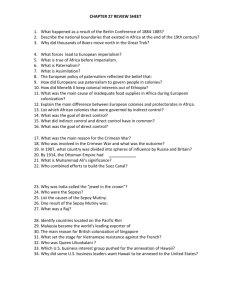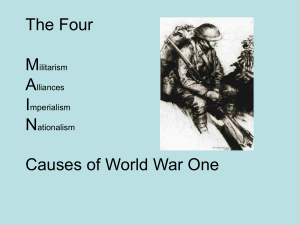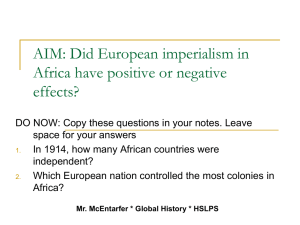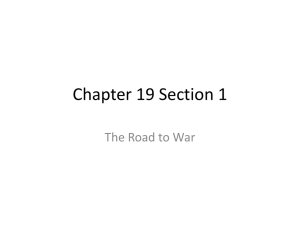19th c test nationalism imperialism - JamesSpagnoletti
advertisement
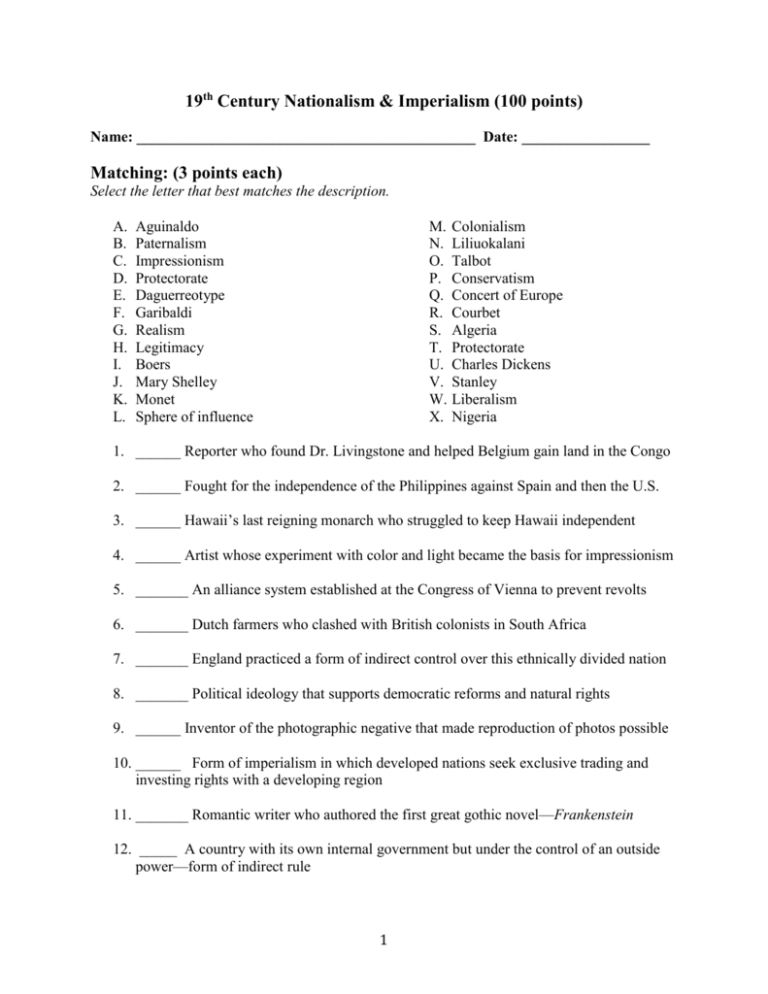
19th Century Nationalism & Imperialism (100 points) Name: _____________________________________________ Date: _________________ Matching: (3 points each) Select the letter that best matches the description. A. B. C. D. E. F. G. H. I. J. K. L. Aguinaldo Paternalism Impressionism Protectorate Daguerreotype Garibaldi Realism Legitimacy Boers Mary Shelley Monet Sphere of influence M. N. O. P. Q. R. S. T. U. V. W. X. Colonialism Liliuokalani Talbot Conservatism Concert of Europe Courbet Algeria Protectorate Charles Dickens Stanley Liberalism Nigeria 1. ______ Reporter who found Dr. Livingstone and helped Belgium gain land in the Congo 2. ______ Fought for the independence of the Philippines against Spain and then the U.S. 3. ______ Hawaii’s last reigning monarch who struggled to keep Hawaii independent 4. ______ Artist whose experiment with color and light became the basis for impressionism 5. _______ An alliance system established at the Congress of Vienna to prevent revolts 6. _______ Dutch farmers who clashed with British colonists in South Africa 7. _______ England practiced a form of indirect control over this ethnically divided nation 8. _______ Political ideology that supports democratic reforms and natural rights 9. ______ Inventor of the photographic negative that made reproduction of photos possible 10. ______ Form of imperialism in which developed nations seek exclusive trading and investing rights with a developing region 11. _______ Romantic writer who authored the first great gothic novel—Frankenstein 12. _____ A country with its own internal government but under the control of an outside power—form of indirect rule 1 Short Answers: (15 points total) 1. Write a thorough definition for “Social Darwinism.” (3 points) _______________________________________________________________________ _______________________________________________________________________ ________________________________________________________________________ ________________________________________________________________________ 2. Identify two positive and two negative effects of African colonialism. *Positive ____________________________________ ____________________________________ *Negative ___________________________________ ___________________________________ 3. Identify four motives that encouraged Europeans to engage in imperialist activities. _______________________________________ _______________________________________ ________________________________________ ________________________________________ 4. Briefly state how romantic and realistic literature differs? Give an example of each. _____________________________________________________________________ _____________________________________________________________________ _____________________________________________________________________ ______________________________________________________________________ ______________________________________________________________________ 2 Multiple Choice (4 points each) Circle the letter of the answer that best completes the statement or answers the question. 1. Menelik II differed from other 19th-century African leaders because A. He managed to maintain his nation’s independence. B. He established colonies in Africa for his own nations. C. He aggressively rebelled against European imperialism causing great destruction in his nation. D. He eagerly adopted European methods of governing. 2. The European policy of paternalism reflected the belief that Africans should be A. B. C. D. separated into ethnic groups. trained to function as leaders. watched over and taken care of. granted more rights and freedoms. 3. Why did some U.S. business leaders want the U.S. to annex Hawaii? A. B. C. D. It would improve trade with Pacific Rim countries. Sugar could be sold for higher profits. They wanted U.S. military support against Hawaiian royalty. They feared that French Indochina might conquer Hawaii. 4. What was the main goal of the participants in the Congress of Vienna? A. B. C. D. to create constitutional monarchies in Europe to prevent nations outside of Europe from interfering in European affairs to establish security and stability for the nations of Europe to prevent the unification of the German states 5. How were the unifications of Italy and German similar? A. B. C. D. Both involved wars with France and England Both took over land controlled by the pope Both unified into an empire Both used military force to unify various territories 6. What was the main purpose of the Berlin Conference of 1884-1885? A. to ensure that African borders would be based on culture and language B. to give African leaders a chance to be heard by colonial interests C. to prevent fighting of European nations over the division of Africa D. to keep peace between Africans and European leaders 3 7. Which of the following was true about nationalism? A. B. C. D. One’s greatest loyalty should not be to a king. One’s greatest loyalty should be to a nation of people. The nation of people should have a common culture. All of the above are true. Interpreting Charts (2 points each) Use the chart to choose the best possible answer. MANAGEMENT METHODS INDIRECT CONTROL DIRECT CONTROL Local government officials were used. Limited self-rule Goal: to develop future leaders Government institutions are based on European styles but may have local rules. EXAMPLES Foreign officials were brought in to rule. No self-rule Goal: Assimilation Government institutions are based only on European styles. EXAMPLES British colonies such as Nigeria, India, Burma U.S. colonies on Pacific Islands French colonies such as Somaliland, Vietnam German colonies such as German East Africa Portuguese colonies such as Angola 1. How did the German style of governing colonies compare to the U.S. style? A. Germany preferred direct control, whereas the United States preferred indirect control. B. Germany preferred indirect control, whereas the United States preferred direct control. C. Both Germany and the United States preferred direct control. D. Both Germany and the United preferred indirect control. 2. Which of the following was the underlying basis for the direct control method? A. B. C. D. reliance on existing political leaders paternalism keeping local rulers the goal of developing future leaders 4 3. Judging from the chart, which of the following colonies would have the most successful experience after independence? A. B. C. D. India Vietnam Somaliland Angola 4. What was true of direct control? A. B. C. D. Local government officials were used. The British preferred it. Local rules were included with European styles. It had no self-rule. 5. What conclusion can be drawn from this chart? A. B. C. D. Indirect control probably caused more loss of cultural identity. Direct control probably caused more loss of cultural identity. Management methods would have no effect on cultural identity. Both management methods caused the same loss of cultural identity. Extended Response (15 points) Choose ONE of the following questions to answer in a two-paragraph response. 1. Describe some similarities and some differences between colonization during the 15001600s and the new imperialism of the 19th-century Industrial Age. 2. How did nationalism and industrialization influence the Romantic Movement in art and literature? Support your answer with examples. 3. During the 1800s, nationalism fueled efforts to build nation-states. Discuss how nationalism was a force for both unity and separation in 19th-century Europe. Support your answer with specific historical details. 4. Do you approve or disapprove of Otto von Bismark’s policy of realpolitik and the methods he used to unify Germany? Support you answer with specific examples. _____________________________________________________________________________________________________ _____________________________________________________________________________________________________ ____________________________________________________________________________________________________ ______________________________________________________________________________________________________ ______________________________________________________________________________________________________ 5 ________________________________________________________________________________________________________ ________________________________________________________________________________________________________ _______________________________________________________________________________________________________ _______________________________________________________________________________________________________ ________________________________________________________________________________________________________ _______________________________________________________________________________________________________ _______________________________________________________________________________________________________ _________________________________________________________________________________________________________ ________________________________________________________________________________________________________ ________________________________________________________________________________________________________ _____________________________________________________________________________________________________ _____________________________________________________________________________________________________ ____________________________________________________________________________________________________ ______________________________________________________________________________________________________ ______________________________________________________________________________________________________ ________________________________________________________________________________________________________ ________________________________________________________________________________________________________ _______________________________________________________________________________________________________ _______________________________________________________________________________________________________ ________________________________________________________________________________________________________ _______________________________________________________________________________________________________ _______________________________________________________________________________________________________ _________________________________________________________________________________________________________ ________________________________________________________________________________________________________ 6 ________________________________________________________________________________________________________ 7
